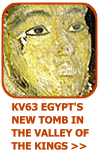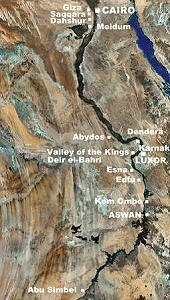|
|
|

Please note: the tour is currently in the early stages of being compiled online - the whole tour should be available to view very soon. Sorry for any inconvenience!
Cairo to Luxor tour
Regular contributor Tony High has put together an online tour starting from Cairo and ending back at Luxor, and taking in all the major monuments and landmarks:
Cairo - "the mother of the world"
Al-Qāhirah is the city's official but less known name. It is the largest city in Africa and the Islamic world. On the east bank, one will find the oldest part of the city, formerly known as Kher-aha ‘Place of Combat’, referring to the site where the epic battles between Seth and his nephew Horus took place. Over the centuries, Egypt has had numerous capital cities, including Memphis, Thebes, On, Alexandria and finally Al-Qahira. It has also had a chequered history, having been occupied by a foreign force since 751 BC; firstly by the Ethiopian Princes ruling from the south, who in turn were overthrown by the Persians, the Macedonians (Alexander the Great), the Ptolemies (Cleopatra) and finally the Romans, whose dominance lasted for some 600 years until the Arabs overthrew the Roman fortresses in 641 AD. The Mamelukes, Turks, and French then followed the Arabs with Egypt’s dominance finally ending in 1807 AD when the British handed direct rule back to Egypt under the pasha Muhammad Ali.
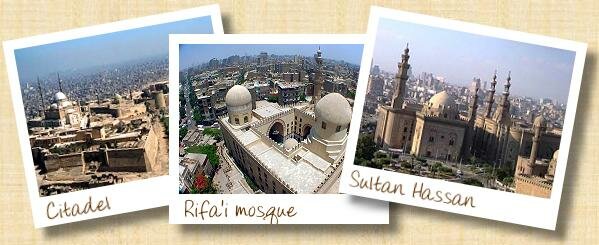
Scenes from "Islamic Cairo" - the medieval quarter by the Citadel. Some beautiful Mameluke architecture and some of the best views of the city from the Citadel. Sunset from here, accompanied by the haunting sounds of the "adhan" (call to prayer) is a truly spectacular experience.
The Fatimid Caliphs, who came from Baghdad, built the first ‘true’ city in the 10th century; they built a walled city, which included palaces, pavilions and sumptuous gardens, in the hope of copying the splendour of Baghdad. This new city was designed for the sole use of the Khalifa and his family and was called El-Kahira ‘The Conqueror’. Named after the planet Mars, (El-Kahir) which legend has it was passing overhead as the foundations of the city were being laid.
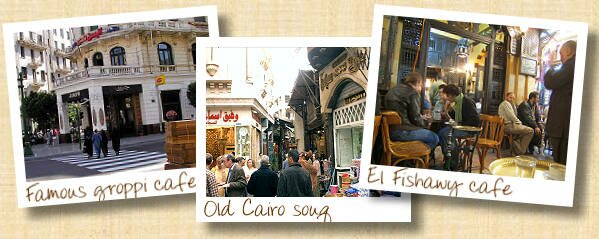
Downtown's famous cafe, Groppi (sells vibrantly coloured soft drinks of the same name that are traditional at weddings), bustling street scenes from "Old Cairo" and another famous cafe, El Fishawy, in the Khan el-Khalil souq - a great place to stop for a mint tea and sheesha (not that we advocate smoking of course!).
In AD1171 Salah-al-Din assumed control of the country after defeating the Christian crusaders, one of his first acts was to expel the royal family from El-Kahira. He opened the ‘Walled City’ to the public, building them an impressive mosque, known as the citadel or ‘The Alabaster Mosque’. This newfound freedom gave rise to expansion allowing the city to become the cultural and commercial centre of the country, which it remains to this day.
In 1805, Cairo was at last under the control of an Egyptian, Muhammad Ali. Eager to ‘drag’ Egypt into the modern world he embarked on a huge building program introducing railways, canals and factories. Unfortunately, due to the very rapid population growth and rural migration, the city was unable to house the ever-increasing population. Originally designed to house 2 million inhabitants, the numbers quickly swelled to over 13 million! The result is that today the infrastructure is unable to cope, leaving hundreds and thousands of people to live on the streets, even resorting to living in old cemeteries; known locally, as the ‘City of the Dead’. Despite all these hardships, the Cairenes are very friendly and good-natured people.
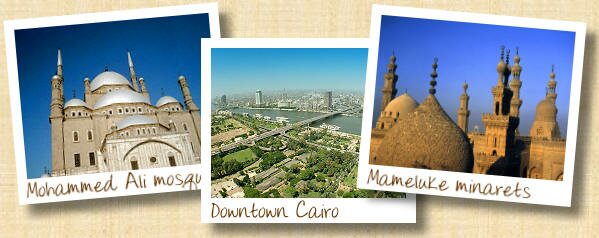
The ottoman style mosque of Mohammed Ali crowns the citadel, views of modern Cairo bisected by the Nile, the beautiful medieval Mameluke minarets and domes of Islamic Cairo.
The city has so much to offer the visitor:
 |
There is the Egyptian Museum with its thousands of wonderful artefacts. Spend at least a day here if you can, and don't miss the Tutankhaum treasures or the equally beautiful treasures from Tanis. |
 |
The spectacular mosques and bazaars. Try "Islamic Cairo" (don't be put off by the name, it simply refers to the concentration of beautiful medieval mosques and vibrant suqs in the area. Don't miss Al Azhar, Sultan Hassan, Mohammed Ali and the Khan el-Khalili. You will feel like you've just stepped out into a page of the "Arabian Nights"! |
 |
The beautiful early Christian churches and the Roman ruins of Babylon at Old Cairo. Don't miss the "Hanging Church" originally built in the 4th century AD with an amazing icon collection. Also the Ben Ezra synagogue where the incredible medieval Geniza records were discovered. This area of the city is actually below the modern day street level! |
 |
And of course the awe-inspiring pyramids of Giza. Need we say more? |
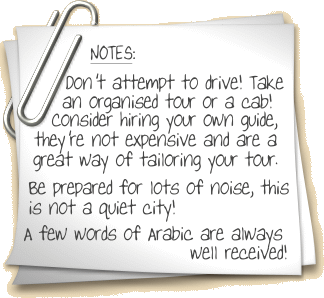
Driving around Cairo is undoubtedly a hazardous, yet comical adventure! (We don't recommend you drive - get a cab or do a coach tour - it's a lot safer). The traffic is a cacophony of noise, with throngs of cars and donkey carts all jockeying for position. From the comfort of your taxi or coach, you will come upon what you think will be an immovable mass of vehicles, all hopes of getting back in time for tea gone. Then with one long ‘beep’ on the horn the mass opens its ranks likening to the Red Sea parting for Moses! Your driver will carefully thread his vehicle through this mass with all the skill and dexterity of a surgeon, missing donkeys and taxis alike by mere millimetres. After a couple of trips around Cairo you will come to behold your driver in awe at his skill and steely nerve, getting you from one side of the Cairo to the other unscathed will truly amuse and astound you. Oh, and don't worry about red lights - nobody stops for them, and very few people use their headlights at night either.
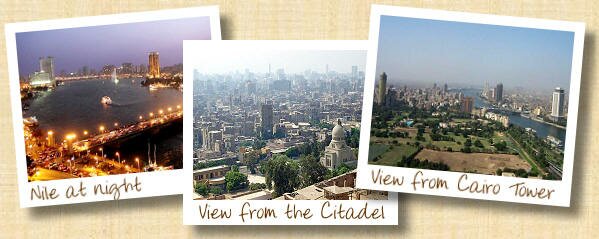
Looking down the Nile at night, view over Islamic Cairo from the Citadel, excellent views over modern Cairo and the Nile (even the distant pyramids!) from the Cairo Tower in Zamalek, an affluent suburb on an island in the Nile. Taking a felucca on the Nile at dusk is a great way to see a more calmer aspect of the city. Restaurant boats also make regular trips down the Nile, affording excellent views of the modern day city.
Next site: The Giza Plateau >>
 Discover more about this amazing city Cairo with these top notch reads: Discover more about this amazing city Cairo with these top notch reads:
 |
 |
 |
 |
 |
 |
| The Cairo Triology by Naguib Mahfouz, nobel prize winner for literature. A sweeping and evocative portrait of both a Cairene family and a country struggling to move toward independence in a society that has resisted change for centuries. Written as a triology: Palace Walk, Palace of Desire and Sugar Street. |
| The Illustrated Guide to the Coptic Museum and Churches of Old Cairo by Gawdat Gabra and Marianne Eaton-Krauss. Egypt's Coptic Church is one of the oldest in the world, and this is a richly informative and illustrated book, perfect for anyone interested in this rich artistic heritage, with superb colour photos. |
| Islamic Cairo. Cairo has more medieval monuments than any other city in the world. This guide outlines the history and architecture of the city and describes the major mosques, madrasas and mausoleums, the citadel, the Khan al-Khalili souq, the Nilometer, and the Museum of Islamic Art. |
| Cairo: the practical guide. Described by "The New York Times" as "indispensable," the basics of daily life and much more are detailed. The book also includes: an A to Z directory of goods, services, and interests subdivided by neighbourhood; a language section on the basics of Cairene Arabic; and details on shopping and sight-seeing from a resident's perspective. |
|
 |
 |
 |
 |
 |
 |
| A woman of Cairo by Noel Barber. For anyone who has visited Cairo, this clever story by the late Noel Barber evokes all the magic and mystery of that great city in the early part of the 20th century, and paints a fascinating picture of two different societies in a time of violent change, set in Egypt from 1919 through to World War II. |
| Islamic architecture in Cairo by D.Behrens- Abouseif. Cairo has one of the highest concentrations of Islamic architectural treasures in the world. Beginning with an analysis of the Cairo's urban growth from the Islamic conquest through to the Ottoman Period, this book provides a "guided tour" of the evolution of Cairo's Islamic architecture and an overview of its main styles spanning 1200 years. |
| Cairo: the city victorious by Max Roedenbeck. Managing to successfully capture the spirit of Cairo, it's people, history, religion, turmoils and future, bringing to life the the anguish, fear and joy of the various people that have moulded Cairo into what it is today. |
| The Art and Architecture of Islamic Cairo by Richard Yeomans. Cairo has a magnificent art and architectural heritage that has lasted over a thousand years. Set within an historical narrative, the stylistic development of the visual arts is explained within changing religious, social and political contexts. Yeomans has created a study of Islamic style which is unprecedented in its historical scope of one of the world's finest and richest architectural legacies. |
| Lonely Planet : Cairo by Andrew Humphreys. Extremely useful as a guide or introduction to modern Cairo. The author's enthusiasm for this ancient city is infectious. Apart from practical information, history and culture are neatly summarised. Perfect for anyone who plans to visit Cairo, or has any interest in it as a city. |
| Insight guide to Cairo. includes a section detailing Cairo's history, eight features covering aspects of the country's life and culture, ranging from the Tentmaker's Bazaar to the treasures of Tutankhamun, a region by region visitor's guide to the sights and a comprehensive Travel Tips section packed with essential contact addresses and numbers. It also contains hundreds of top-notch photographs and maps. |
Next site: The Giza Plateau >>
|
|
|






